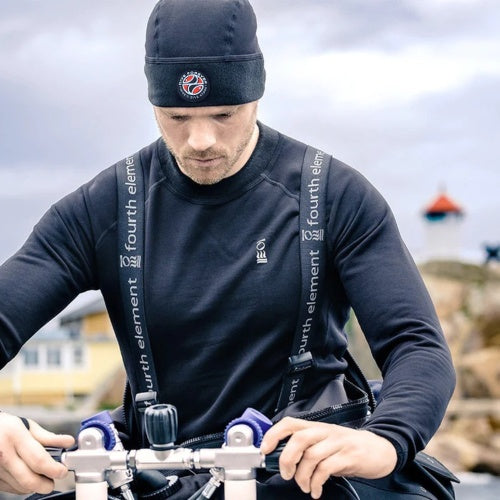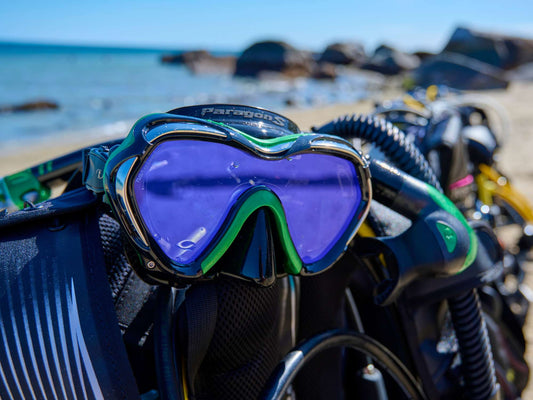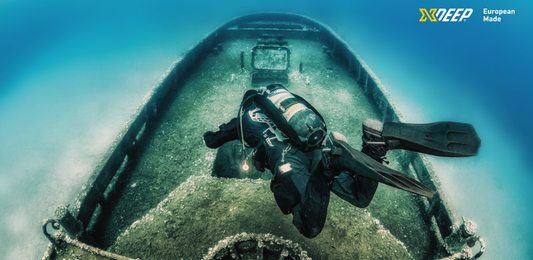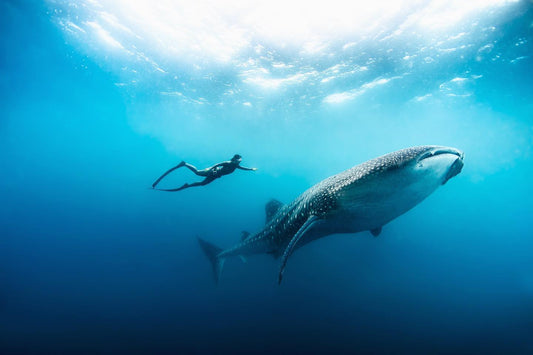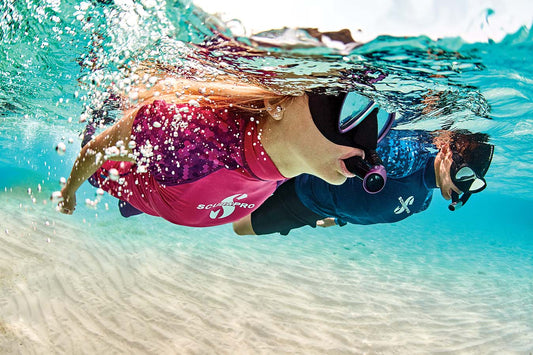written by Tim Harrison, updated by Shem Dec 2022
How to choose an undersuit for Drysuit Diving
Picking the best choice of undersuit or combination of layers and thicknesses for the water temperature you will be diving in will make a massive difference to your enjoyment of the dive.
Unfortunately, because there are so many variables involved there is no hard and fast rule or formula for how to choose the best undersuit as every diver and every dive is different. Things like your physical condition, body composition drysuit materials and how hard you work during a dive can all affect how tolerant you are to temperature changes. The best advice must always be considered alongside your own knowledge of how you react to different temperatures.
A little knowledge
So, what keeps you warm whilst diving in a drysuit? For the most part it is the air that is sealed within your suit and to a lesser degree the materials that your drysuit and undersuit are made of. In theory, the more air you trap the better the insulation but trapped air spaces are not a divers friend. Air has a nasty habit of compressing and expanding as the pressure (depth) changes as well as being buoyant in water, so whilst the theory is that more air equals warmer the real-world practicality is that more air means more weight to compensate the buoyancy on the surface and a greater buoyancy fluctuation as you get deeper.
So, the perfect undersuit needs to be a balance between warmth, bulk, buoyancy and compression. A tall order perhaps but don’t forget that the answer doesn’t necessarily have to reside in just one product.
Layering Up
Going straight for the thickest undersuit for winter diving isn’t necessarily the best option. There are big advantages to opting for a combination of layers. Having a range of different thickness garments will allow you mix and match to achieve the best choice for your dive but it will also allow you to tailor your final system for best performance.
The layer in contact with your skin needs to do a particular job. Even when you are relaxed, calm and comfortable your body sweats so your undersuit needs to be able to move this moisture away from the skin to prevent you becoming damp and cold. Most undersuits use materials that are fast wicking but base layers such as the Fourth Element J2 Baselayer Set are ideal as they have been specifically designed to achieve this.
Something to bear in mind is that cotton is terrible at wicking moisture. It will just get caught within the fabric, getting wetter and colder so making you wetter and colder. If you aren’t going to use or need a baselayer don’t be tempted to wear a standard cotton T-shirt instead otherwise you’ll just be making it tougher for your undersuit to its job.
Where you go from here is very much up to you but we’ll give you a bit of a guide as what as to what sort of thickness undersuit or specific product falls into certain temperature bands to give you a starting point.
Temperatures
Remember that these are only guides as there are so many variables involved but if you would like to get some further advice and help buying an undersuit please give us a call on 0208 994 6006 or come and see us in store.
These suggestions are based more for membrane or trilaminate drysuits, you can adjust slightly on the thinner or cooler side for a neoprene suit.
Undersuits for water temperature 20ºC +
You are going to be nice and toasty down there in your drysuit so you’ll probably only going to need a base layer to wick the moisture away from your skin. Here are some top options:

Undersuits for water temperature 15 – 20ºC
Average summer UK sea temperature range so just a little nippy perhaps towards the end of the dive. A good base layer will help to keep your skin comfortable and dry whilst a thin thermal layer should give you ample protection against the cold. If you feel cold quickly you can always go for a slightly thicker thermal layer.

Undersuits for water temperature 10 – 15ºC
Things are getting colder now so you’ll need to choose a thicker thermal layer. Your trusty base layer will continue to do its job, leaving the thermal layer to do all the work of helping to keep you warm. As an upgrade if you feel the cold you could swap the base layer for a thin thermal layer but make sure the material has good wicking properties.

Undersuits for water temperature 5 – 10ºC
We are into winter UK sea temperatures here. You are almost certainly going to need two thermal layers, a thinner one (like the Fourth Element Xerotherm) to act as your base layer and a thicker layer for warmth. If you are nearing the bottom on this temperature range you might also want to consider an extra layer over your body core to help keep your temperature up.
As well as the thicker and dual layer options we mentioned above you might want to consider something a little more advanced like the Fourth Element HALO AR Men's Undersuit which uses varying layers, materials and thicknesses in different regions of the body to offer the best insulation solutions. Fourth Element call this Biomapping and it is a result of lengthy research into body heat loss.
- Fourth Element HALO AR Women's Undersuit
- Fourth Element HALO AR Men's Undersuit
- Waterproof Nord Men's Undersuit
- Waterproof Nord Women's Undersuit
Undersuits for water temperature 1 – 5ºC
Layer, layer, layer ….. literally. Plenty of thermal layers needed here. A good thermal base layer, thick middle layer and perhaps something extra over your core such as a Waterproof 3D Mesh Vest which maintains insulating air gap using anti-compression materials. You can use pretty much any combination of different garment types and thicknesses we have mentioned before to achieve something that works for you.
If you feel the cold you might want to look into something a bit more specialised that take advantage of some pretty interesting materials and designs. The Fourth Element Halo AR uses a combination of different thicknesses and layers across different regions of the body to create an advanced full undersuit. On top of that it uses anti-compression materials to maintain the insulating air gaps around your core and makes you look pretty awesome too.
- Fourth Element HALO AR Women's Undersuit
- Fourth Element HALO AR Men's Undersuit
- Waterproof Nord Men's Undersuit
- Waterproof Nord Women's Undersuit

